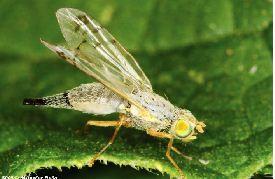Safflower: Insect pests Management
Safflower: Insect pests Management
Gram pod borer
BiologyIt is a polyphagous pest, infesting gram, lablab, safflower, chillies, groundnut, tobacco, cotton etc.
- Egg: Spherical, yellowish eggs are laid singly on tender parts and buds of plants. The egg period lasts for 2-4 days.
- Larva: Caterpillars are of varying colour, initially brown and later turn greenish with darker broken lines along the side of the body. Body covered with radiating hairs. When full grown, they measure 3.7 to 5 cm in length. The larval period lasts for 18-25 days. The full grown caterpillar pupates in the soil.
- Pupa: Pupation takes place inside the soil in an earthen cell. Pupal stage lasts 7-15 days.
- Adult: Moth is stout, medium sized with brownish/greyish forewings with a dark cross band near outer margin and dark spots near costal margins, with a wing expanse of 3.7cm.
- In early stage of crop growth larvae feed on leaves and shoot apices.
- Later, the larvae shift to the developing capitula.
- The symptoms are perforated leaves, perforated involucral bracts, partially or completely eaten capitula in the bud stage and bored developing capitula.
- Parasitoids: Trichogramma spp., Tetrastichus spp., Telenomus spp., Chelonus spp., Microchelonus curvimaculatus, Enicospilus sp, Eriborus argenteopilosus, Bracon spp., Ichneumon spp., Carcelia illota, Palexorista solennis, Sturmiopsis inferens, Goniophthalmus halli, Campoletis chlorideae etc.
- Predators: Lacewing, ladybug beetle, reduviid bug, spider, red ant, robber fly, black drongo (King crow), common mynah, big-eyed bug (Geocoris sp), earwig, ground beetle, pentatomid bug (Eocanthecona furcellata), preying mantis etc.
Safflower caterpillar
The insect occurs throughout India. It is a regular pest of safflower
Biology- Egg: The female lays an average of 345-371 green coloured eggs either singly or in clusters on the crop foliage. The incubation period varies from 4 to 5 days.
- Larva: The larval duration varies from 2-3 weeks.
- Pupa: The pest pupate in soil and it last about a week.
- Adult: The adult is a dark brown in colour, medium sized moth with pale wavy marks on forewings. Caterpillar is stout, green and smooth. The anal segment is humped and the body has some purple markings.
- The larva feeds on the leaves and sometimes on capitulum too.
- It also feeds on bracts, flowers, capsule Enormous yield losses of 62.6 to 100% have been encountered due to excessive foliage feeding by a large number of larvae.
- Parasitoids: Apanteles ruficrus, Rogas percurrens, Euplectrus euplexiae, Eriborus argenteopilosus, Pteromalus sp etc.
- Predators: Lacewing, ladybug beetle, reduviid bug, spider, red ant, robber fly, black drongo (King crow), common mynah, big-eyed bug (Geocoris sp), earwig, ground beetle, pentatomid bug (Eocanthecona furcellata), preying mantis etc.
Safflower fly/capsule bud fly
Biology Egg: Eggs are laid in clusters of 6 to 24 which hatch in a day.
Egg: Eggs are laid in clusters of 6 to 24 which hatch in a day.- Pupa: Pupation takes place in flower buds.
- Adult: The adult flies are ash coloured with light brown legs.
The flies are active during March and infestation of flower buds takes place after a week.
Damage symptoms- Newly hatched maggots feed on the soft parts (ovaries of florets and thalami of capitula) of capsules and later instars feed on the soft part within.
- The infested buds rot and give an offensive smelling fluid.
- Parasitoids: Orymurus sp., Eurytoma sp, Bracon spp. etc.
- Predators: Lacewing, ladybug beetle, reduviid bug, spider, red ant, robber fly, black drongo (King crow), common mynah, big-eyed bug (Geocoris sp), earwig, ground beetle, pentatomid bug (Eocanthecona furcellata), preying mantis etc.
Safflower aphid
Both nymphs and adults when on stem are found with their head directed towards the soil. Alate and apterous forms are commonly seen an aphid colony. The alates are found in the beginning of the season (November- December) and again towards the maturity of the crop, while apterous forms are abundantly found between the two extremes mentioned above.
BiologyAn asexual-viviparous mode of reproduction is reported in this aphid species.
- Nymph: Nymphs are reddish brown. Nymphal stage with four instars lasted in an average of 9.34 days.
- Adult: Aphids are soft bodied insects and 1.5 to 2 mm in length. Adults are large sized, black with pear-shaped body and conspicuous cornicles, winged or wingless. An average fecundity of 89 off springs per female has been reported. Adult longevity, pre-reproductive and reproductive periods last for 14.9, 1.28 and 14.6 days, respectively.
- During pre-flowering stage both nymphs and adults suck the cell sap from shoot apices, peduncles, leaves and stem, secrete a honey dew like secretion on upper surface of the leaves and plant parts forming a black sooty mold which hinders photosynthetic activity resulting in stunted growth.
- Finally the plants dry up.
- Honey dew excreted gets deposited on the upper surface of the leaves, on which sooty molds grow and hinder the photosynthesis, resulting in stunted growth and poor yields.
- In case of heavy infestation the plants dry and die. Infestation may start even when the crop is 15 days old.
- About 40-50% yield losses are observed due to this insect.
- Infestation may occur 30-45 days old crop.
- Parasitoids: Aphelinus sp, Aphidencyrtus aphidivorus, Pseudendaphis sp
- Predators: Lacewing, ladybug beetles (Coccinella arcuta, Micromus cinearis, Ischiodon scutellaris, Harmonia octomacuiata, Coccinella repanda), reduviid bug, spider, red ant, robber fly, hover fly, big-eyed bug (Geocoris sp), earwig, ground beetle, pentatomid bug (Eocanthecona furcellata), preying mantis etc.
IPM for Safflower
To know the IPM practices for Safflower, click here.
Source: NIPHM and Directorate of Plant Protection, Quarantine & Storage
Last Modified : 2/13/2020
Natural enemies of Safflower insect pests are cove...
This topic covers information about Chilli insect...
This topic covers the Information related to Crop ...
This topic covers the Information related to Disea...
